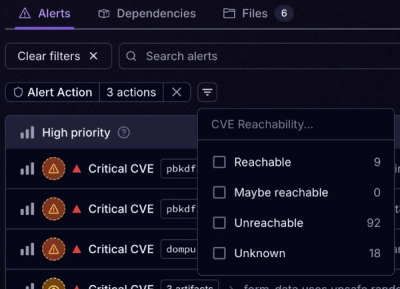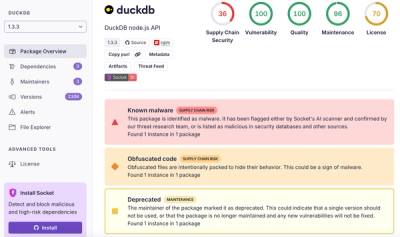
Product
Introducing Tier 1 Reachability: Precision CVE Triage for Enterprise Teams
Socket’s new Tier 1 Reachability filters out up to 80% of irrelevant CVEs, so security teams can focus on the vulnerabilities that matter.
cude-animations
Advanced tools
cudeAnimations is a lightweight simple JavaScript library that can be used to create custom animations.
cudeAnimations is a lightweight simple JavaScript library that can be used to create custom animations.
The minified library weights 8kb before gzip. It relies on a promise polyfill, so if your project doesn't include that beforehand, you can use cudeAnimations.withpoly.min.js instead of cudeAnimations.min.js.
When using the polyfied version, cudeAnimations.js supports all browsers.
Simply include the cudeAnimations.min.js file from the dist folder in your project or install via npm using the package name cude-animations.
After including the file the classes are available through the global variable cudeAnimations.
If using ES6 modules, the library exports the following modules:
ScrollAnimator (Class) - not documented yetAnimate (Class)When instantiating a new animation, an options paramter is expected. The options parameter is an object containing the following parameters:
start = {number} The value to start the animation from.end = {number} The value to end the animation at.duration = {number} (optional) duration of the animation in ms. Default: 250.reverse = {boolean} (optional) If true animates from end to start value. Default: false.customEasing = {(t:number, b:number, c:number, d:number)=>void} (option). Default: easings.easeInOutExpo. See section below about custom easing functions.target = {string} query of html elements. Needs to be specified if the manipulator is not specified. When used, the library will replace the inneHTML of the elements with the value (rounded to 0 decimals).manipulator = {(value:number, end:boolean)=>void} Is called once for each keyframe, needs to be specified if the target is not specified. The manipulator is the recommended way of controlling animation. Keep this function as efficient as possible, as it may be called often.Example using target:
var options = {
target: ".animate-this-element",
start: 0,
end: 100,
duration: 1000
}
var animation = new cudeAnimations.Animate(options)
animation.start()
Same example using manipulator:
// Find the element manually.
// Don't do this inside the manipulator function
var element = document.querySelector(".animate-counter span")
// Keep this function as efficient as possible, as it may be called many times
manipulator = function(val){
element.innerHTML = val
}
var options = {
manipulator: manipulator,
start: 0,
end: 100,
duration: 1000
}
var animation = new cudeAnimations.Animate(options)
animation.start()
The start() method returns a Promise that is resolved once the animation is finished. This can be used to easily create chained animations.
Example of chained animation:
var options = {
target: ".animate-this-element",
start: 0,
end: 100,
duration: 1000
}
var options2 = {
target: ".animate-this-element-after",
start: 0,
end: 100,
duration: 1000
}
var animation = new cudeAnimations.Animate(options)
var animation2 = new cudeAnimations.Animate(options2)
animation
.start()
.then(animation2.start)
You can optionally apply your custom easing function, which will receive 4 parameters necessary to calculate a Bezier curve:
t (the current time);b (the beginning value);c (the difference between the beginning and destination value);d (the total time of the tween).You could use any of Robert Penner's easing functions.
If you don't specify a custom easing function, the default is easeInOutExpo.
Example:
const linear = (t, b, c, d) => {
return c * t / d + b;
}
const options = {
target: ".mySelector",
customEasing: linear
start: 0,
end: 100,
duration: 1000,
}
new cudeAnimations.Animate(options).start()
This library also contains methods for controlling the animatino using scroll, instead of a duration.
Still needs to be documented. See scrollAnimation for example.
FAQs
cudeAnimations is a lightweight simple JavaScript library that can be used to create custom animations.
The npm package cude-animations receives a total of 0 weekly downloads. As such, cude-animations popularity was classified as not popular.
We found that cude-animations demonstrated a not healthy version release cadence and project activity because the last version was released a year ago. It has 1 open source maintainer collaborating on the project.
Did you know?

Socket for GitHub automatically highlights issues in each pull request and monitors the health of all your open source dependencies. Discover the contents of your packages and block harmful activity before you install or update your dependencies.

Product
Socket’s new Tier 1 Reachability filters out up to 80% of irrelevant CVEs, so security teams can focus on the vulnerabilities that matter.

Research
/Security News
Ongoing npm supply chain attack spreads to DuckDB: multiple packages compromised with the same wallet-drainer malware.

Security News
The MCP Steering Committee has launched the official MCP Registry in preview, a central hub for discovering and publishing MCP servers.